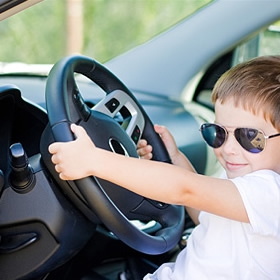Article at a Glance
- At a very young age children are already learning driving habits from their parents’ examples.
- Learning how to drive well is important—motor vehicle fatalities are the leading cause of death for 15 to 20 year olds.
- Set a good example when driving and take time to teach your children about traffic laws.
Kids start learning how to drive long before they ever take a driver’s education course. After years of driving them around town, you would be surprised how much they have picked up from you. If we want our children to be safe drivers we need to set a proper example now.
Inexperience puts our teens at a serious disadvantage when driving. Not only are teens three times more likely to get into a car accident, but motor vehicle fatalities are the leading cause of death for 15 to 20 year olds. Helping our children develop good driving habits from the very start can help save lives.
Here are some things you can start doing right now to help your children be better drivers later.
- Don’t text or use your phone while driving and avoid any other distractions. Explain to your children the risks.
- Follow traffic laws and be respectful to others on the road. Explain some of the choices you make while driving and tell your children about traffic rules.
- If it is raining or snowing, talk to your children about how you alter your driving to fit roadway conditions.
- Always buckle up and insist that your children do the same. Children 13 and under should always ride in the back. Make sure you always have enough seat belts or car seats for your passengers.
- Talk with your children about how important it is to ride with a capable and experienced driver. Avoid having them ride with other teenage drivers. The chances of getting into a fatal accident dramatically increases the more teen passengers there are in the car. Teach your children to speak up if somebody they are driving with is speeding or driving recklessly. Let them know that you will always be willing to pick them up if they need you to.
- Make sure your children understand the dangers of driving under the influence and teach them to never get into a car with somebody who has been using drugs or alcohol. About 31% of car crash fatalities involve alcohol. Drivers under 21 years old are not allowed to have any alcohol in their system when operating a motor vehicle.
- Help your children become familiar with local roads. They will thank you for it later. Getting lost or confused about where you are going can be a dangerous distraction while driving.
- Talk about the financial and legal consequences of disobeying traffic laws or getting into an accident. Allow your children to suffer the consequences for little things now so that they will understand that they are responsible for their actions when the stakes are higher.
- Tell your teens that their grades will determine how much they have to pay for car insurance. Teens with better grades can usually get a discount.
- When your children get older and start riding with other people consider putting together a passenger agreement that sets forth clear guidelines, consequences, and rewards. Once they start driving, you can put together a drivers agreement. For ideas see countdown2drive.org and the Parent Teen Driving Agreement (kidshealth.org).
Share this article:
